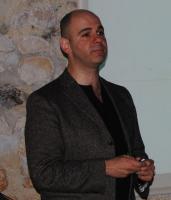Dr. Güven EKEN President of Doga Dernegi, the Turkish NGO partner of Birdlife.
Güven EKEN and his team have participated in the identification of Mediterranean key biodiversity areas led by the Critical Ecosystem Partnership Fund (CEPF).
« 70 key biodiversity areas were identified as individual priority sites, because they are both highly irreplaceable and threatened and therefore require immediate conservation attention».
1 – Can you explain how and why Doga Dernegi was involved in the CEPF project ?

Doga Dernegi (DD) was instrumental in developing the initial Key Biodiversity Area methodology, and it was also the first NGO in the world to apply it so as to produce a KBA inventory for a whole country – Turkey in this case. So, since DD is based in the Mediterranean Basin, when the CEPF decided to launch the Ecosystem Profile for this global Hotspot, Doga Dernegi appeared as a natural leader. It undertook the work with the participation of respected partners worldwide. The profiling team includes Tour du Valat, Conservation International’s Center for Applied Biodiversity Science (CABS), the partners of BirdLife International in the region, IUCN, WWF International and PlantLife as well as many others throughout the region.
2 – What is the added value of this new map/profile compared with what already exists?
Each profile reflects an assessment of biological priorities and the underlying causes of biodiversity loss, socio-economic parameters, threats and an inventory of conservation-related investment taking place within the region. This information is analyzed to identify strategic investment opportunities for CEPF in the Southern and Eastern parts of the Mediterranean Basin.
Compared to previous existing tools, the Ecosystem Profile will provide a common strategy by many organisations, using standard methods. It brings together a dispersedexpert knowledge from many different NGOs.
3 – What is the main difference between KBAs and priority KBAs?
A total of 1,105 key biodiversity areas were identified. In addition, 17 “corridors” (i.e. clusters of similar or connected KBAs) were identified containing 432 key biodiversity areas. These corridors are essential for protecting the processes and linkages required to support threatened species, particularly in terms of long-term adaptation to climate change.
But we have to make some choices: the CEPF has only 10 million dollars to invest. As the number of KBAs – or even corridors – is too high compared to resources, priorities for investments by the CEPF had to be set up. This was made using 2 main criteria: Irreplaceability (i.e. KBAs that contain species found nowhere else in the world) and Vulnerability (i.e. sites that need to be conserved now, otherwise they will be soon destroyed).
Notre expertise a permis de démontrer que sur les 17 corridors identifiés, 6 étaient d’importance primordiale parce qu’ils abritaient la plupart de la biodiversité endémique et menacée de ce « hotspot ». Ces corridors ont été identifiés en fonction de leur importance dans la préservation de services écologiques essentiels, dans la résilience des écosystèmes aux changements climatiques, et du rôle qu’ils jouent dans la maintenance de l’intégrité biologique de ce « hotspot ». Les investissements manquant sur ces sites, le soutien du CEPF et de la société civile permettra d’assurer l’intégrité écologique de ces corridors. C’est le cas par exemple dans le sud-ouest des Balkans, les montagnes de l’Atlas, le Taurus en Turquie…
Applying expert knowledge of the 17 corridors identified, 6 corridors of overwhelming importance were shown to contain the majority of threatened and endemic biodiversity in the hotspot. These corridors were identified for their importance in safeguarding essential ecosystem services, ensuring ecosystem resilience to climate change, and for their role in maintaining the biological integrity of the hotspot. Additionally, these sites lack sufficient investments and with CEPF support, civil society can make great strides towards securing the ecological integrity in these corridors. For example: the Southwest Balkans; the Atlas Mountains; the Taurus Mountains in Turkey… Furthermore, 70 key biodiversity areas (both inside and outside of these corridors, and from the eligible countries – i.e. south and east Mediterranean) were identified as individual priority sites, because they are both highly irreplaceable and threatened and therefore require immediate conservation attention. Most of these key biodiversity areas are inside the priority corridors but others represent highly irreplaceable and vulnerable sites in other corridors.
4 – What are the next steps for this project?
In July, the Ecosystem profile will be proposed for validation to the CEPF Council. Then, before CEPF can launch its investment in the region, it will need to recruit the regional implementation team. This is a competitive process which will provide all organizations in the region with an opportunity to undertake this key role. This team will be in charge of managing the conservation funds to be invested in the coming years in the Hotspot.
Finally, NGOs and other organisations located in eligible countries, i.e. the Southern and Eastern Mediterranean. will be invited to submit projects aiming at conserving priority KBAs
On 30th March, the Tour du Valat and Doga Dernegi organized a regional workshop of the Critical Ecosystem Partnership Fund (CEPF) with 15 countries, large NGOs like Birdlife, WWF, IUCN… and some foundations. They discussed the current status of the profiling process and prepared the future actions for the preservation of these priority biodiversity areas.